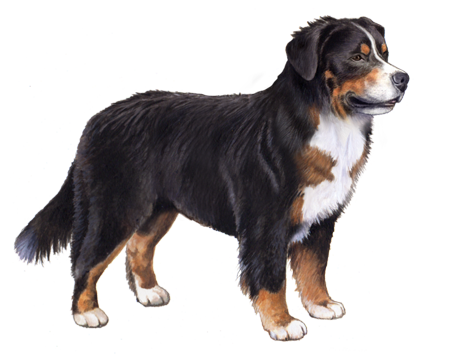
Landseer (European Continental Type)
The Landseer is a loyal, playful, and confident family dog. The breed thrives when given plenty of space to run and exercise, and doesn’t do well when left alone.
Interested in discovering if your dog is a Landseer (European Continental Type)?
Check out Wisdom Panel's DNA tests.

Landseer (European Continental Type) Traits
General Appearance
This large breed dog is similar in appearance to a Newfoundland, with its broad and massive features, large paws, and friendly, almond-shaped eyes. They are a longhaired breed with fur that’s dense and fine, and they have unique black and white markings.
Coat and Colouring
The Landseer has a double coat that’s long and dense on the outer coat, interspersed with a less dense undercoat. They are white with black on the torso and rump.
A Landseer’s neck, front breast, barrel, belly, and tail are white, and their head is black.
Distinctive Physical Traits
The Landseer is similar in physical appearance to the Newfoundland. However, its white snout with a solid white blaze makes this breed unique.
Landseer (European Continental Type) Temperament
The Landseer is a gentle, loving, and loyal family dog when they are properly trained and socialized.
Because of their large size, they generally need a lot of space to roam, exercise and play with their people. They can be territorial and possessive, and their independence can make it challenging to train them at times.


Landseer (European Continental Type) History
Although the Landseer started its journey in Newfoundland, Canada, it became quite popular in 19th-century England.
Experts believe that the Spaniards, Portuguese, and Basques who visited Newfoundland before the English brought their version of the shepherd dog with them for protection; the Landseer and Pyrenean Mountain Dogs then mixed, accounting for the similarities between the two types of dog. Upon discovering these dogs, English explorers fell in love and brought them back home. The first Kennel Club stud book in 1870 contains mentions of the Landseer breed. In 1900, Swiss and German breeders started to take breeding of the Landseer seriously, working to create the standard—including their black and white markings—from which all purebred Landseers would follow.
Landseer (European Continental Type) Care
Nutrition
Your Landseer is a large breed that will do well with any age-appropriate, high-quality dog food that’s suited to their particular weight and any additional health concerns.
As with any dog, it’s important to monitor the amount of food and treats that you give your Landseer, especially since some dogs are prone to gaining weight as they age. Your veterinarian is always a good source to help provide you with appropriate nutrition and feeding guidelines.
Grooming
The Landseer’s double coat is generally easy to maintain, and a once-weekly brush with a pin brush for the body and comb for the feathering, behind the ears, and the tail should be plenty.
All dogs require regular dental care, including at-home teeth brushing and professional dental cleanings, and the Landseer is no exception. Maintaining good dental hygiene is important for their overall long-term health.
Exercise
This strong and agile breed is active and requires moderate exercise. A daily walk, run, or game of fetch in a fenced-in backyard will keep a Landseer happy. What the Landseer truly enjoys, though, is swimming, and they will jump in the water at every opportunity.
Training
The Landseer is a gentle and smart breed, and they are generally pretty easy to train. Keep in mind that a Landseer’s puppy stage can last up to 18 months, which is longer than most dogs. They respond best to training that involves positive reinforcement, and early socialization is a must.

Landseer (European Continental Type) Genetic Health Conditions
-
Cystinuria Type I-A
Dogs with Cystinuria are not able to reabsorb the amino acid cystine in their kidneys and therefore high concentrations can accumulate in the urinary tract resulting in formation of cystine crystals and stones that can cause obstruction.
-
Muscular Dystrophy (Discovered in the Landseer)
Muscular Dystrophies are a group of progressive disorders leading to muscular dysfunction. This form leads to movement difficulties from a young age due to increasing muscle weakness.
Knowing if your Landseer (European Continental Type) is a carrier or at-risk for these conditions can help you and your veterinarian plan for your pup's lifelong care. With Wisdom Panel™ Premium, you can get results for over 200 genetic health tests.
Breed Group
Mountain Dogs
This genetic group was bred for hard work in mountainous regions. Characterized by their thick coats and sturdy, larger builds they quickly became the invaluable working companions of people in endurance activities such as drafting and hauling.


















